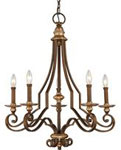Combining Different Light Fixtures in One Room
Aug 5th 2010

To get the best lighting effect in any room, you need to have multiple light fixtures. More importantly, you need to have the right amount of different types of light fixtures. But how do you know which types of fixtures you need? The key is to understand your lighting options and the way they are each incorporated into the room.
Three Primary Types of Light Fixtures
There are generally three types of light fixtures that you should have in each major room of the house:
1. Task lighting. As the name suggests, this type of lighting refers to the lights that are going to be used for different tasks in the home. For example, you may have a reading lamp in the bedroom or office that serves as the light for your reading tasks.
2. Accent lighting. Accent lighting is similar to task lighting in that it lights a specific area. However, the purpose is not functional (as with task lighting) but instead is decorative. Accent lighting directs your attention to key items in the room that you want to show off. For example, you may use accent lighting to highlight your favorite piece of artwork hanging on the wall.
3. Ambient lighting. Ambient lighting is different from the other two types of lighting in that it is designed to light the whole room. This is typically achieved by using an overhead hanging light.
The Correct Order for Selecting Your Light Fixtures
The biggest mistake that people make when choosing a room’s light fixtures is that they choose the ambient lighting first. The thinking here is that you want to take care of the biggest space first and then add to it. However, this thinking is backwards. Choosing your light fixtures this way typically ends up creating harsher light than what you want in your home. The correct order for choosing your light fixtures is:
1. Task lighting. Select all task lighting first. Define what the purpose of the room is. If multiple tasks are to be completed in the room then determine whether you want matching or complimentary light fixtures. Select as many task lighting fixtures as you need for adequate light to complete all regular tasks in the space.
2. Accent lighting. After choosing your task lighting, you can add your accent lighting. You will want to highlight only one or two areas of a room with accent lighting. You don’t want your accent lighting to compete with your task lighting. It should be subtle and should compliment the task lighting that you choose.
3. Ambient lighting. Finally, choose your ambient lighting last. Although it is spread throughout the room, this light is really designed to fill in the spaces that aren’t covered by the other two types of lighting. If you have chosen very bold designs for your other fixtures then choose an understated overhead lighting fixture for your ambient lighting. If you have stuck to simple fixtures in the rest of the room, you can make a dramatic statement with the style of your ambient light fixture.
Final Tips for Multiple-Fixture Room Design
Some final things to take into consideration include:
- Choose fixtures in similar styles. You don’t want all of your fixtures competing for attention in a room. Unless you have a very eclectic design style, stick with a similar style for all fixtures in the space.
- Consider a dimmer switch for your ambient lighting. Even if the fixture itself is the boldest piece in the room, the light should really just be filler so you want to be able to dim it when you’re using the room’s other lights.
- Remember that task lights can be overhead hanging lights. Your ambient lighting doesn’t have to be the only hanging light fixture in a room. Pendant lights can be terrific task lights especially over work areas like desks and counter space.
- There are advanced lighting options as well. You aren’t limited to these three types of fixtures. You can also explore uplights, backlighting and kinetic lights if you want to add something special to your rooms.
- Look at the shadows in the room before you finish the lighting design. When you have selected the major lights for your room, you can play around with turning them on and off in different combinations. What you should look at is not the light itself but rather the shadows that are left in the room. This tells you where more lighting may be necessary.
It does take time to choose the right light fixtures for your space but having a well-lit well-decorated room is totally worth that effort!
